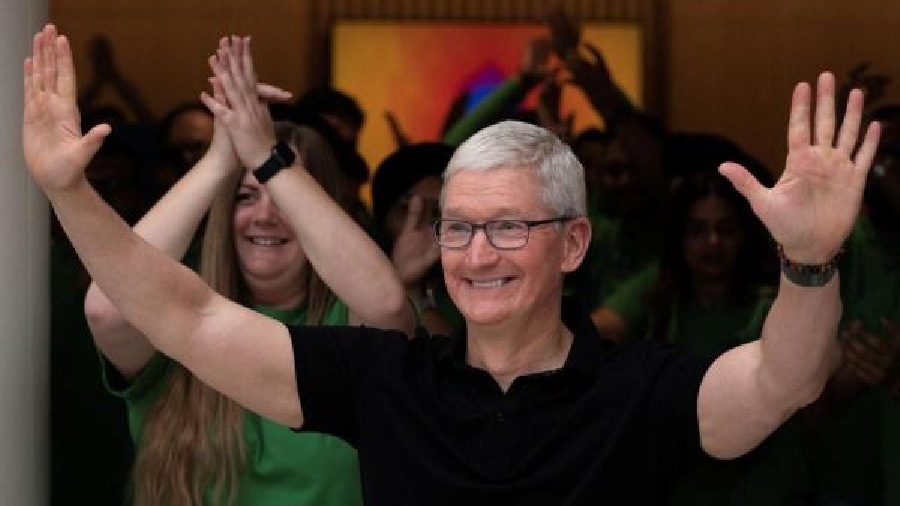Time did not seem to be pressing on Tim Cook as he leaned into a MacBook, scrutinising every technical detail that has gone into the making of Mali’s — or Maalavika Manoj — unreleased song. She is a young musician who grew up in Chennai, now trying to join the dots to make her career blossom in Mumbai. Her 2021 debut album, Caution to the Wind, has already laid a strong foundation.
She is trying to find fresh ears for her music that sounds equally fresh, thanks to her creamy tone and depth. As she sang, it was obvious that something quite special was going on inside the Apple CEO’s mind. His face was a couple of shades brighter than it was 10 minutes ago and his body language, relaxed. He had the golden hour feel though the sun was far from calling it a day.
Between the MacBook and the moment Mali picked up a guitar, there was a short conversation that highlighted Tim’s love for meeting members of the creative community. Mali brought up the topic of the iPod and how it started a revolution in her head when she was young. Packed with music that ultimately opened up the mind to possibilities, the iPod took her a few steps closer to realising what she wanted to do with her life. Of course, back then she didn’t know that one day Tim Cook would be listening to her music and asking when her new unreleased songs would no longer remain unreleased. He was genuinely kicked.
As soon as Tim asked her about how deep she was into the world of Logic Pro and plugins, Mali showcased the excitement of a kid in a toy store. She then explained how different Apple products help shape her music. Later, she was thrilled when the topic of GarageBand (helps create music and podcasts) popped up. Musicians like Mali bring joy to Tim, whose company has been steadfastly presenting products that make life simpler for everyone.
iPod to Apple Music
Being privy to the conversation, I wondered what Tim thought about the creative community using different Apple products to come up with pathbreaking projects, from music to films to art and whatnot. By now he was seated on a low sofa in the music room.
“Apple got its start focusing on two groups of people — education and creatives. There were a number of different creatives… there were musicians, there were creative graphics…. And then, we started focusing on movies as well and so forth.
We had the musician sort of deep in our DNA from the very start… from the Mac… and then you saw a different expression of that with the iPod. The iPod did such a great thing for music, it allowed all of us to listen to a variety of music because what was happening with the CD-ROM, like the Sony Walkman, at the time, was that people would listen to the same CD over and over again, because they wouldn’t replace it. In their car, they would listen to one, or if they were lucky to have a CD changer, they would listen to more (CDs) over and over and over again. But all of a sudden (with the iPod), you could put 1,000 songs in your pocket. And then 1,000 songs blossomed into 40,000 songs or more. Then we democratised the download process, so people could legally pay for music, pay the artiste, but get the songs that they wanted; it took it to a whole different level. The iPod itself introduced Apple to so many people that had never been introduced to Apple before,” said Tim without allowing our eye contact to slip.
With the iPod in 2001 appeared the iPod Generation. On the one hand, it once again brought musicians and listeners closer and on the other, the iPod became the blueprint for design enthusiasts. It was a bold tool for the era when seen in conjunction with iTunes.Apple obviously didn’t stop there. “Later, we bought and began to invest significantly in Logic Pro, because we wanted to really focus on the creative process of music even more,” said Tim before he weaved in GarageBand into the conversation.
“GarageBand is for the very young artistes. It’s such a great place to start. I went to a school this morning. And a part of what they use is GarageBand… in the creation process. We always view ourselves as a toolmaker. We make tools for people to be able to express themselves creatively. So whether it’s the Notes app, or Voice Memos, or Logic or GarageBand, all of these things are in the service of the creator, the musician in this case.”
Apple’s roadmap for any sector they touch is well-planned. Without being in a hurry to send out statements that make for good optics, the company thinks it through and slowly builds a house that can withstand strong winds.
Tim went on to explain the next step in the process — Apple Music. “Apple Music provides a platform where you can not only drop your music in your local country, but you can all of a sudden drop it globally. And it’s a phenomenal thing because (earlier) you had to negotiate geography by geography. Now all of a sudden… your creation is global. All of this is in pursuit of helping artistes and as I said we have an enormous focus on artistes. It has, I think, served Apple well and the artistes’ community very well.”
Spatial Audio, a path-breaking technology
The launch of Apple Music in 2015 was a defining moment. As the years roll by, the platform is going deeper and deeper into the hearts of music lovers, be it by way of selection, algorithm or technology.
In a way, Apple Music celebrates Steve Jobs’ love for music. What better way to bring about a change in how we listen to music than through Apple Music and how it now champions Spatial Audio with support for Dolby Atmos?
By default Apple Music automatically plays Dolby Atmos tracks on all AirPods and Beats headphones with an H1 or W1 chip, as well as the built-in speakers in the latest versions of iPhone, iPad, and Mac. Once you listen to Spatial Audio, it’s impossible to turn to any other sound. For decades, music was mono. Then it went stereo, immortalising the music of the Beatles and Beach Boys. The third defining chapter is Spatial Audio in which the listener is sort of made to sit at the centre of music, making the experience immersive. It’s a technology that’s giving more power to musicians like Mali as well as music producers.
“We’ve felt that music should be like the artiste intended. And we’re very focused on the artiste. And so the idea that you could hear music in a different kind of way was something that we really wanted to conquer with what you’re calling high-def music or spatial audio or lossless… many people have many different descriptions, and so forth. There wasn’t a lot of innovation in there for a while.”
Taking the point further, Tim said: “Music had gone through the stages, of going from a cassette to CD-ROM to everybody ripping music, and then streaming music and so forth. But those were all delivery mechanisms. But there hadn’t been really innovations in the sound itself… for all of us… in a democratised way. Pretty soon Spatial audio will be like the colour TV… that supplanted the black-and-white TV. People will wonder how they ever lived without it.”
Music canbreak down walls
There are many similarities between Steve Jobs and the man he recommended take over from him, Tim Cook, one of them being music. Steve’s love for The Beatles and Bob Dylan is well known. For Tim, jazz holds a special place. He had “aspirations of playing in a jazz band” and early on in his life, he was in a marching band (he played the trombone). The music he grew up to was classic rock. What’s more important is what he believes in: “Music can break down the walls between people a lot in a world that’s all too divisive.”
Music of any kind can bring people together, also classical. The conversation slightly veered towards the company’s latest endeavour — Apple Music Classical, which, as the name suggests, celebrates classical music. That Apple is serious about music is clear from the effort it has put into the app, especially the way in which metadata gets handled.
“I’m getting so many notes about Classical and from people that said that they finally have a place for them. The big unlock for us was realising that you could never combine the music and classical music together in one service, that you needed a separate app. And that was a huge unlock. I’m just getting tons of favourable feedback,” said Tim.
Tools for filmmakers
Music is one part of the story when it comes to helping creators. Photographers and filmmakers know the importance of improvising. Over the years, the iPhone proved that the best camera for taking photos is the one in your pocket. The lens on the iPhone camera is top-notch and there is a bunch of friendly photo-capturing tools. Many professional photographers have made a switch from photography to “iPhoneography”.
The same is happening among filmmakers. When Sean Baker made Tangerine in 2015, critics heaped praises on the film for its “cinematic wide-screen look”. It was shot on the iPhone. When Sean trained the iPhone on nonprofessional actors, they felt comfortable.
Since then, many more tricks have been added to the iPhone to help filmmakers like Arati Kadav. It was not an ordinary Friday for Arati as she arrived at Dhan Mill in Delhi. She had a fan coming in a bit to hear her talk about The Astronaut and his Parrot, the film she shot on the iPhone and it eventually got her the best director award at the Fantasia Film Festival last year. The actor she chose for the poignant tale was Ali Fazal. Last year, he told me: “The film was shot on an iPhone (vis-a-vis traditional cameras) but the emotions were personal and it’s hopefully as real as possible. My interactions with her (Arati) made me believe in the world (we created). That’s cinema. You want to imagine and want to bring that imagination to everybody.”
This is exactly what Tim wanted to know from Arati — the magic of cinema and the iPhone. After hearing the filmmaker speak passionately about her craft, I asked Tim about how the power of the different Apple devices is being harnessed among filmmakers. “We provide people tools. These tools help them create amazing films. And one of the tools we provide is the iPhone. You can see that it has gone from democratising photography to now democratising filmmaking. It used to take hundreds and thousands of dollars for the rigs to shoot. Now you can shoot a film on an iPhone and have the flexibility of the form factor. You have got things like Cinematic Mode; things that are done with the filmmaker in mind.”
Even a man who is used to mounting films on a large scale and has access to any kind of budget, is turning to the iPhone. Earlier this year, Vishal Bhardwaj made a short film called Fursat that has been shot on the iPhone. It has everything Vishal is known for — colourful settings, dramatic movements, songs, dance… the works.Two elements of the film stand out — cinematic framing and action. Vishal took full advantage of the Action Mode on the iPhone 14. It allows supercharged stabilisation for very intense motion. It’s particularly helpful if you are running behind an object. Second, Cinematic mode, which has been around since iPhone 13 and was updated recently. With Cinematic mode, the iPhone camera can record videos with a shallow depth of field and add beautiful focus transitions for a cinema-grade look. “This idea of democratising things for all of us, this is what Apple is all about. We want [to help] those who want to be a filmmaker, and that combined with editing on the Mac with Final Cut Pro is an amazing combination,” said Tim.He has a good suggestion for young filmmakers: “I would just get started. We have iMovie; it’s a great place to start before you go to Final Cut Pro. And the iPhone, from a capture point of view, is unbelievable. I would look to the role models in the industry and what they are doing. And just start learning.”
The thriving creative community in India
The message of “just start learning” also rang through the corridors of Indian School of Design and Innovation, which Tim visited soon after unveiling his company’s first retail store in India — Apple BKC in Mumbai. At the university students unleash their creativity across different sectors, be it fashion, designing or even typography.
Tim took his time and tried to soak in everything the students were doing. As he moved from one table to another, one thing was common — the iPad. It was there everywhere because of the way it helps students. Be it preparing sketches of what can potentially make it to the ramp during a fashion show or shelves at shops or working around different textures or designing a bicycle, students are using the iPad to the max. Every table had a new surprise for Tim and it made him go back to the idea of Apple being a toolmaker.
“They make my heart sing because what we are is a toolmaker. To see fashion being designed, to see sustainable bicycles being made, to see creative graphics… it’s just amazing. It wasn’t too many years ago when you would kind of (get) pushed into a career path of an engineer, or a doctor maybe. And now it’s so great that there’s a creative community that’s blossoming out there. It’s quite alive in India.”
India’s digital revolution has sparked a creative awakening amongst the youth. Ninety-five per cent Gen Z see creativity as essential to their future with 94 per cent enrollment in design majors (Adobe India Study, Ministry of Education).Not so long ago, the creative realms were the reserve of the privileged few, from Bollywood families and the established music industry. However, the cultural landscape in India is changing dramatically. These barriers and obstacles are being brought down by the rise of social media and OTT platforms.
Now, there’s a whole new realm of young creators who are YouTubers, filmmakers, photographers, bloggers, VFX artists, designers, and chefs amongst others, who believe there’s an opportunity to be successful and challenge the assumption of the “privileged” creative few. Today, there are more than a million Indian creators on YouTube, of whom 200K creators who have more than 100K subscribers across entertainment, lifestyle and learning.
Spearheading this revolution are young creatives like Pooja Dhingra who initially enrolled at a law school in Mumbai before quitting in 2004, switching careers to attend a hospitality and management course. Three years later, she began training at Le Cordon Bleu in Paris. She opened her first store in Mumbai in March 2010 with the goal of creating Parisian-styled culinary experiences in India. She is now known for her chain of Le15 patisseries, packaged treats and cookbooks.
Tim got to meet her and said the macarons she creates are “the best”. “Her passion for baking and the business she’s created is a reminder of what’s possible when you follow your dreams. Great to see how she uses iPhone and Mac in her creative process,” he tweeted.
Message for20-year-old Tim
During the few days I saw Tim talk to students, filmmakers, app developers, musicians and people visiting the new Apple stores in India, one thing was clear — he was clearly excited to the point he was caught on camera experiencing jaw-dropping moments seeing people turn up with a Mac from the 1980s to get autographed and children waiting to see “Uncle Cook”. India is where celebrities are largely members of the film and sports fraternity. But when thousands turn up to meet — or at least catch a glimpse of — Tim, one wonders why? Many of the people we met over five days kept talking about how Apple products are fuelling their creative dreams. Apple is in the workshop of fashion designers, in the musician’s studio, in the hands of filmmakers and in the bags of students.
Steve Jobs once said of creativity and design: “Some people think design means how it looks. But of course, if you dig deeper, it’s really how it works…. Creativity is just connecting things.” And Apple is helping connect the dots.
Apple products continue to evolve but the core philosophy of being toolmakers to bring about change remains the same. On the way out, I asked Tim what message he would have shared with a 20-year-old version of himself, one who is using all the different Apple products.
“I would tell myself to remember that the joy is in the journey. Because all too often you forget that and you keep thinking about the next destination and the next destination.”
Music, films and design are not tangible. These can’t be eaten or drunk. Yet, Apple knows that these will always remain some of our most prized possessions.
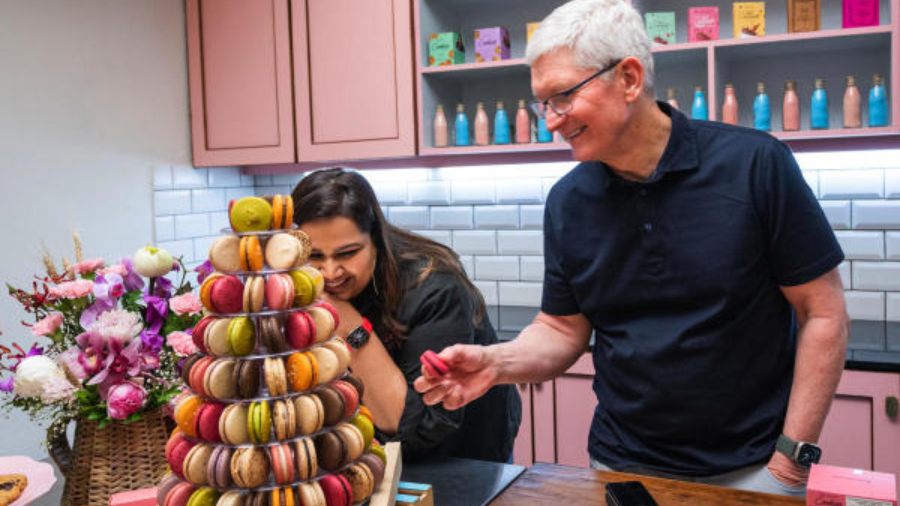
At Pooja Dhingra’s kitchen. Tim said: “Best macaron I’ve ever had!”
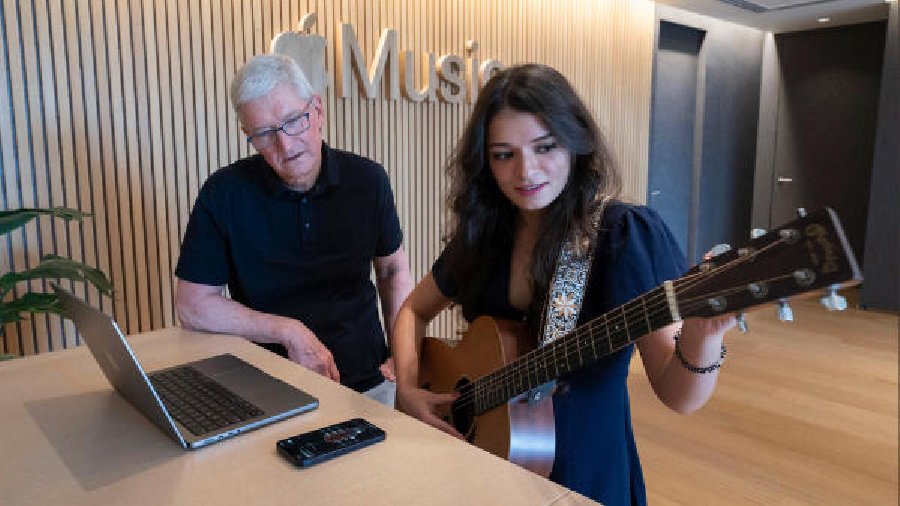
Tim Cook with musician Mali. The singer showcased how she uses Apple products to create music, “from songwriting with iPhone to developing unique beats on MacBook Pro”
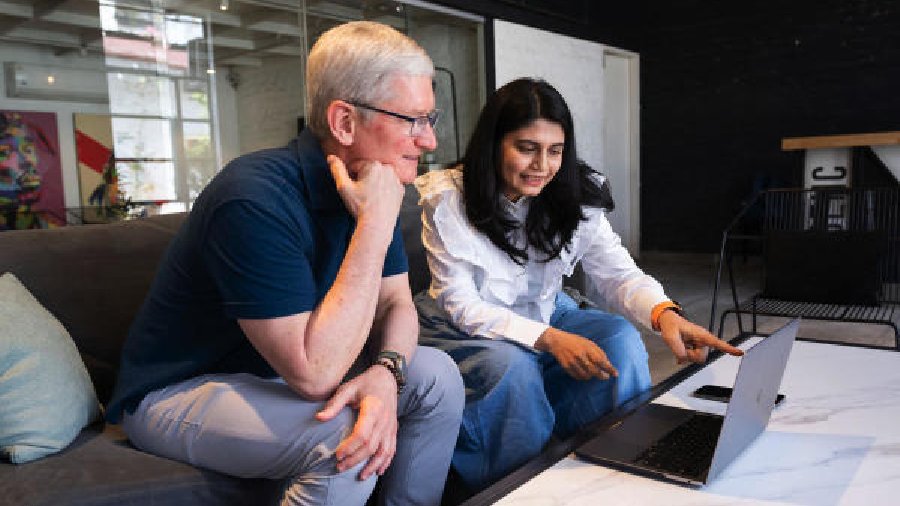
Tim Cook interacts with sci-fi filmmaker Arati Kadav, learning how she made The Astronaut and His Parrot using only her iPhone and MacBook Pro
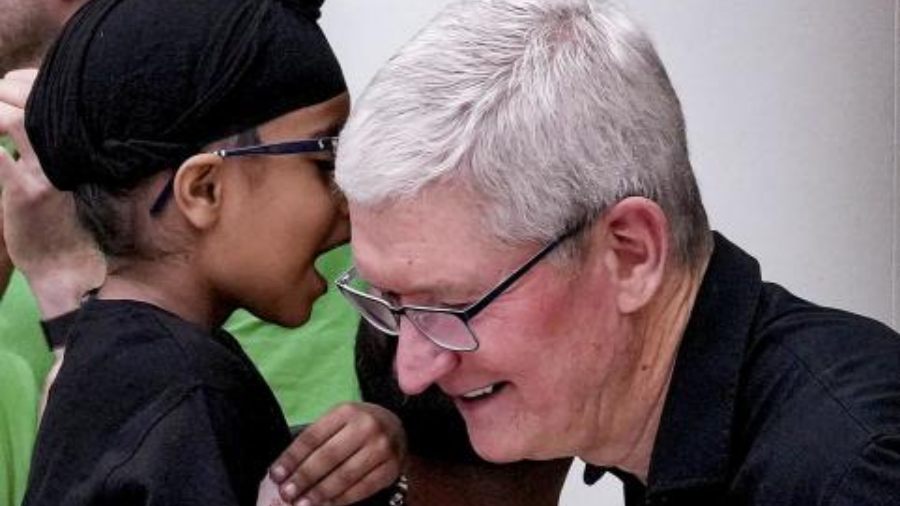
Tim Cook greets Ranvir Sachdeva at Apple Saket in Delhi

The Apple CEO listens to students at the Indian School of Design & Innovation as to how his company’s tools are unlocking creativity
